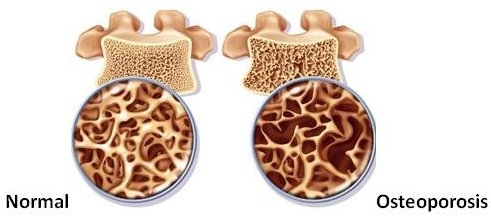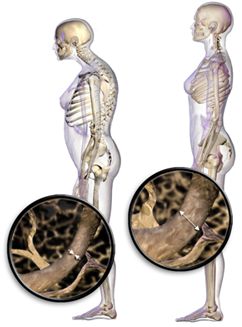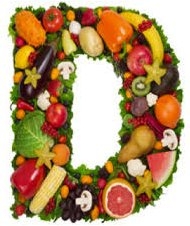You’re walking through a crowded hallway and someone accidentally shoves you against a wall. You hear a crack. When you get to the doctor, they tell you that your shoulder’s been fractured, and that, because of your age, it may be osteoporosis.
So what is osteoporosis? Let’s look at it etymologically. Osteo means bone, and porosis means porous. When you have osteoporosis, your bones have
become porous - having many holes, like a sponge - as opposed to being dense. Since your bones are so porous, they have a higher chance of breaking when you fall. Osteoporosis, as a disease, is characterized by low bone mass and deterioration of bone tissue, which leads to high bone fragility and risk of broken bones, especially of the wrist, shoulder, spine and hips.

About
1.4 million Canadians have osteoporosis. The disease is more common in women, but men can develop it as well. 25% of women over the age of 50 and at least 13% of men over the age of 50 have osteoporosis, and at least 34% of women and 20% of men will have an osteoporotic fracture in their lifetime. Be aware that although osteoporosis is common in older individuals, it can happen at any age. To check for osteoporosis, doctors can perform bone mineral density tests or comprehensive fracture risk assessment.
Osteoporosis is called the “
silent thief,” because it slowly “
steals” bone density over time without any symptoms. Many people aren’t even aware they have osteoporosis until a bone breaks! The cost of treating osteoporotic fractures is high, too, with the Canadian healthcare system spending
$2.3 billion as of 2010
[1].
There are several risk factors that play a role in the development of osteoporosis, and it’s important to be aware of them since osteoporosis has no symptoms. The more risk factors a person presents, the
higher the risk of osteoporosis:

- Being age 65 and over, as bones naturally thin with age
- Having a family history of osteoporosis, especially on the maternal side
- Having a parent with a hip fracture
- Early menopause, as estrogen levels drop and bones lose density during menopause
- Low calcium intake
- Low weight – if you weigh less than 125lbs or 10lbs less than you did at age 25, your risk of osteoporosis is increased.
What can you do to
prevent osteoporosis? The main step is ensuring you have enough calcium in your diet. Bones are the primary location of the body’s calcium, so when other parts of the body need calcium for their processes, calcium is taken from the bone, which depletes its stores. Replenishing these calcium stores will help to keep bones strong. Different populations require different optimal levels of calcium intake.
- Men and women aged 19-50, as well as pregnant/breastfeeding women over age 19, require 1000 milligrams daily.
- Women aged 51-70 and men and women 71 and older require 1200 milligrams daily.
The best food sources for calcium are dairy products such as: milk, cheese, yogurt, and calcium-fortified orange juice.
Vitamin D is also vital for osteoporosis prevention, and it can be found in foods such as fish, milk and egg yolks. Drinking 2 cups of milk or a fortified soy beverage daily ensures the body gets enough vitamin D.
Other steps to take to prevent osteoporosis are as follows:

- Reducing caffeine intake: caffeine can decrease the amount of calcium stores in the body as well as interfere with the body’s metabolism of vitamin D, which is needed to absorb calcium.
- Reducing alcohol intake: having more than three drinks a day increases the risk of osteoporosis
- Avoiding high sodium foods
- Keeping active: Regular exercise that involves weight-bearing aerobic exercise and resistance training helps bone development and maintenance.
- Preventing falls that cause fractures
Your bones are vital for structural support and movement, and ensuring that they’re in the best condition helps to improve both your quality of life and your satisfaction.

 About 1.4 million Canadians have osteoporosis. The disease is more common in women, but men can develop it as well. 25% of women over the age of 50 and at least 13% of men over the age of 50 have osteoporosis, and at least 34% of women and 20% of men will have an osteoporotic fracture in their lifetime. Be aware that although osteoporosis is common in older individuals, it can happen at any age. To check for osteoporosis, doctors can perform bone mineral density tests or comprehensive fracture risk assessment.
About 1.4 million Canadians have osteoporosis. The disease is more common in women, but men can develop it as well. 25% of women over the age of 50 and at least 13% of men over the age of 50 have osteoporosis, and at least 34% of women and 20% of men will have an osteoporotic fracture in their lifetime. Be aware that although osteoporosis is common in older individuals, it can happen at any age. To check for osteoporosis, doctors can perform bone mineral density tests or comprehensive fracture risk assessment.

